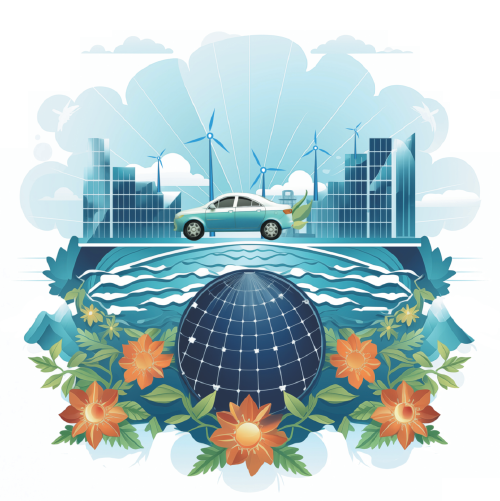Experts' views on green energy

MA XUEJING/CHINA DAILY
Editor's note: As the world is grappling with climate change effects and global rise in temperatures, China is acting as a responsible country by placing a high priority on shifting its requirements toward green energy resources. In fulfilling its responsibility, China is not only making good use of conventional and unconventional energy resources but also shifting toward green energy. Three experts offer their insights to China Daily.
At the front of world's energy transition
By Asit K. Biswas/Cecilia Tortajada
A vast number of people around the world are aware that China is among the world's largest energy consumers and emitters of greenhouse gases. However, an overwhelming majority of them are unaware that China is also the global leader in nearly all aspects of renewable energy generation, production, manufacturing and export. This has been possible because of the emphasis Chinese policymakers have consistently given to renewable energy in the post-2005 period. Appropriate and timely policies have enabled a thriving and dynamic environment within which all aspects of renewable energy production and use have flourished.
Renewable energy includes solar, wind and hydropower generation, and China has made more progress in these areas than any other country during the past two decades.
Primarily because of innovative and consistent policies over the past 15 years, China has been instrumental in reducing the costs of solar and wind energy generation across the world. As a direct result of these Chinese innovations, costs of generating per unit of solar and wind power have become competitive with fossil fuels; in many instances they have become even lower.
Not only China but the entire world has greatly benefited from the lower costs of renewable energy generation, which would not have happened within a short timeframe if the Chinese policies had not reduced generation costs. This has facilitated the steady global transition from fossil fuels to renewable sources for electricity generation.
China has benefited significantly from its investments in research to generate more energy from renewable sources than fossil fuels. According to estimates made by Bloomberg, global investment in renewable energy, in 2022, was nearly half a trillion dollars. China alone accounted for 55 percent of this. It invested $164 billion in new solar installations and another $109 billion in wind energy. It invested more in solar and wind energy generation compared to the United States and all of Europe combined.
China global champion of solar, wind energy
These huge investments over the past years have meant that China is now the global champion, by far, in the generation of both solar and wind energy. For example, by the end of 2022, China had installed 392 gigawatts of solar plants which were operational. This is more than the rest of the world combined.
In terms of installed onshore and offshore wind energy generation, China had more than 310 GW by the end of 2022, which was nearly double of what it had been in 2017. To put China's progress into global perspective, this means it had installed nearly the same amount of wind energy as the other top seven countries of the world combined. By any yardstick, these are remarkable achievements.
When President Xi Jinping announced in December 2020 that the country will triple its solar and wind generation capacity by 2030, very few people outside China thought this would be possible. Our estimates indicate that China would exceed this target handily well before 2024 is over, some six years before the target date.
Major solar installations are located in the northern provinces of Shanxi and Hebei and Xinjiang Uygur autonomous region in the northwest. The combined capacity of these three provinces in 2022 was 52 GW. This is higher than the total operating large utility-scale solar energy installations in the entire US for that year.
In terms of onshore wind energy, much of it comes from the Inner Mongolia autonomous region (41 GW), and from Hebei and Xinjiang (22.9 GW each). For offshore wind, nearly 75 percent of production comes from Jiangsu (12 GW), Guangdong (8.9 GW) and Fujian (3.5 GW).
In recent years, China has invested heavily in transmission lines to carry the electricity generated to other parts of the country, a practice that is not conducive for developing solar and wind power. In August 2023, 98.8 percent of solar energy and 97.8 percent of wind energy generated were used. This indicates China is using its solar and wind energy very efficiently.
The third leg of China's renewable energy generation has been hydropower. In 2020, by the end of its 13th Five-Year Plan, hydropower was the main source for renewable electricity generation, at 16 percent of total national electricity production. It was followed by wind (6 percent) and solar (4 percent) power. China has given hydropower significant national priority during the post-2002 period, more than any other country in the world.
Hydropower dams help water, food security
China has been active in not only constructing hydropower dams within the country but also in numerous other countries. Before 2000, Chinese enterprises had built only six hydropower dams outside the country. By 2020, the enterprises had built around 320 dams in 140 countries, with total generating capacities of 81 GW. Chinese enterprises are now responsible for 70 percent of the global market in dam construction and the manufacture of associated hydraulic machineries.
Hydropower dams have not only helped China's transition to renewable energy but also ensured its water and food security. Similarly, the dams China has constructed in 140 countries have contributed to enhancing their water, energy and food security, while helping in the transition from fossil fuels to renewable energy. This has also contributed to their national development processes.
An important constraint with renewable energy generation is: what is to be done when the sun does not shine and the wind does not blow? As China's energy transition accelerates and exponential growth in solar and wind energy takes place during the next three decades, a major issue will be energy storage during the periods when solar and wind energy cannot be generated. Accordingly, China is now investing heavily in research and development so that battery storage becomes consistently more efficient and economic. Currently, China plans to have 100 GW of battery storage by 2030.
Another form of energy storage China is pursuing is pumped hydro schemes. This requires two reservoirs, one at a higher level and the other at a lower level. When solar and wind generation is low but energy demands are high, say during evenings, water is released from higher to lower reservoirs to generate electricity. During the days when solar and wind energy is generated, and thus higher levels of energy are available, water is pumped back from the lower to the higher reservoirs.
Currently, China has the largest operational pumped storage capacities in the world, at 50.7 GW. It is followed by Japan (23.7 GW) and the US (21.6 GW). The plan is to increase China's pumped storage capacities to at least 62 GW by 2025, 120 GW by 2030 and 305 GW by 2035.
Going forward, Global Energy Monitor, an independent think tank, estimates that China will account for 81 percent of all new pumped storage that would be constructed all over the world during the next three decades.
There are several important reasons as to why China has made unprecedented progress in developing solar and wind energy. First is the strong and consistent support from the highest levels of policymakers, including significant funding for research and development in all aspects of renewable energy, timely policy interventions, including providing good incentives and favourable zoning laws that allows for quick and objective approval of renewable energy projects. Second is strong public support for renewable energy, especially when people see the air quality in important urban centers has improved significantly during the last decade, and is still improving. The general public also realizes that carbon emissions in China have to be progressively reduced so that climate change impacts can be properly managed.
The commitments made by President Xi that China's carbon emissions will peak before 2030 are now almost guaranteed to be met. This leaves his second major commitment, that the country will become carbon neutral before 2060. While it is difficult to predict how things may develop during the next 30 years, on the basis of China meeting all its environmental targets before time and the current road map to carbon neutrality, it is highly likely that China will meet its carbon neutrality target before 2060. This will be good for China and the world, and for the global environment.
Asit K. Biswas is a distinguished visiting professor at the University of Glasgow in UK; director of Water Management International in Singapore.
Cecilia Tortajada is a professor of the School of Social and Environmental Sustainability at the University of Glasgow.
China devoted to a shared green future
By Erik Solheim
Recently, I paid a wonderful visit to the headquarters of Chinese battery manufacturer CATL in the small city of Ningde in Fujian province and was taken into the exciting future of the electric battery world.
CATL, founded by Zeng Yuqun in 1999 as ATL, started as a small factory and quickly grew to become the world's biggest electric battery manufacturer. It leads the global market, holding one-third of the market share.
CATL's newest batteries last longer than the car and run 1,000 km on one charge. The batteries can charge in a few minutes and are the safest in the world. CATL is on the road to unlocking "game-changing" batteries as its top scientists lead the research into future solid-state and metal-free batteries. The company has injected transformation and innovation in the industry and is one of the world's most important companies in the green revolution.
As the world's largest provider of electric batteries, CATL has been enhancing its global footprint through partnerships with outstanding automakers such as BMW, Daimler, Hyundai and Toyota. Notably, CATL is the main supplier to Tesla. As the battery is half the value of an electric vehicle, it is hard to say whether a Tesla is an American car with a Chinese battery or a Chinese battery with an American carrosserie.
Unlike the situation some years ago when Western countries led in many frontier technologies, global electric battery production so far is dominated by China's CATL and BYD, South Korea's LG Energy and Japan's Panasonic. These Asian companies together hold over 90 percent of the market share, leaving very little space for participants from the West or elsewhere.
Electric batteries may be the most important technology for the green revolution. We need them for cars, but also to store energy, as the sun is not shining and the wind not blowing all the time, every day. China now is at the forefront of the green transformation. The world simply cannot go forward without China. It has become the indispensable green partner for the rest of the world. China leads in nearly all industries critical to the green shift, accounting for 60-80 percent of all solar, wind and hydro power as well as electric cars, buses and batteries, and high-speed rail. China is taking green technologies to scale, leads innovation and makes green products cheaper and accessible.
The United Nations Framework Convention on Climate Change (COP28) is taking place in Dubai soon (Nov 30-Dec 12). Few expect any major breakthroughs from the talks. But the event is also a climate fair, where progress is showcased, business deals made and where people learn from each other. Climate talks are no longer the main drivers of change. The economy is. The drastic fall in the price of renewable energies is more significant to our struggle than texts at a conference table. Climate action taken by political leaders and business is the real key to climate success.
China is leading the way on many fronts. In addition to being a global leader in green technologies, China has moved to the front seat on nature conservation.
China is by far the most enthusiastic tree-planting nation in the world, having planted more than 78 billion trees in the past four decades, doubling the forest coverage rate from the early 1980s.
To build a beautiful China, the country has launched an ambitious plan for national parks. It is on track to keep 230,000 square kilometers of land under protection, giving space to key endangered species such as the giant panda, snow leopard, Siberian tiger and the Tibetan antelope.
A massive mangrove conservation and restoration project is another amazing accomplishment. China has become one of the few countries in the world to see a net gain in mangrove cover. By 2025, over 18,000 hectares of mangrove forests will be created and restored. Shenzhen will host the first international mangrove best practice center.
Cities in China such as Shenzhen, Hangzhou and Chengdu have evolved at an amazing speed, becoming among the world's greenest cities along with Amsterdam, Paris, Singapore or Hyderabad. Shenzhen owns some of the greatest green corridors in the world and leads the world in electric buses and taxis. Hangzhou has won a number of environment awards and just hosted a "green" Asian Games. Chengdu makes the headlines for its green buildings and the pioneering approach to building the city with nature.
Fifteen years ago I would never go jogging in most Chinese cities, the smog was so thick. Now China has basically won the war on pollution, the sun is clear and the sky is blue. In the same period China has moved to global leadership in nearly all green disciplines. Together with the other global giants like the US, the EU and India this will change the world. Smaller countries can also be inspired to fight for an ecological civilization.
A shared green future requires a joint effort. The world needs to unify, working and succeeding together in this great endeavor and making breakthroughs which would define the future for mankind.
The author is the vice-chairman of the Europe-Asia Center, a nonprofit based in Brussels, and former UN deputy secretary-general and executive director of the UN Environmental Programme.
Photos
Related Stories
- China's energy output maintains steady growth
- China Development Bank issues over 100 bln yuan in special loans for energy supply
- China's installed capacity of renewable energy surges
- Chinese vice premier stresses energy supply, winter heating
- Renewable energy capacity grows robustly
- China's rural policy bank ups financial support for green projects
Copyright © 2023 People's Daily Online. All Rights Reserved.









